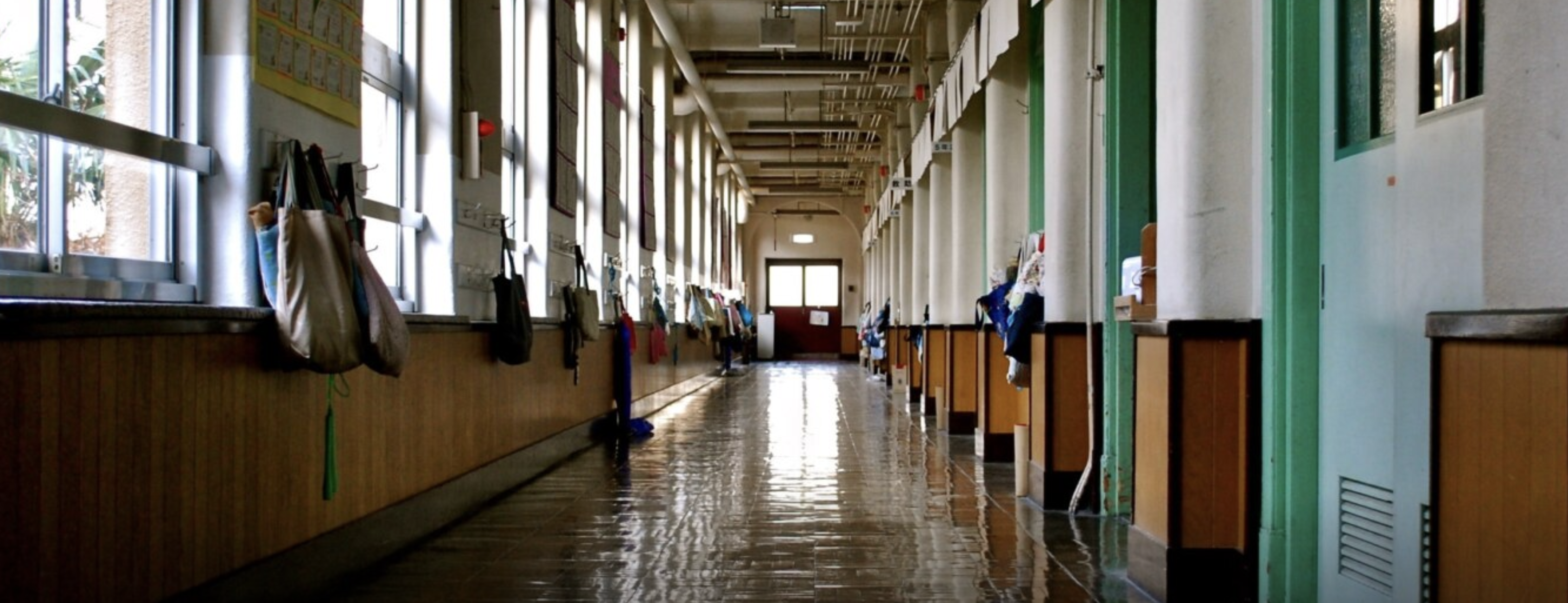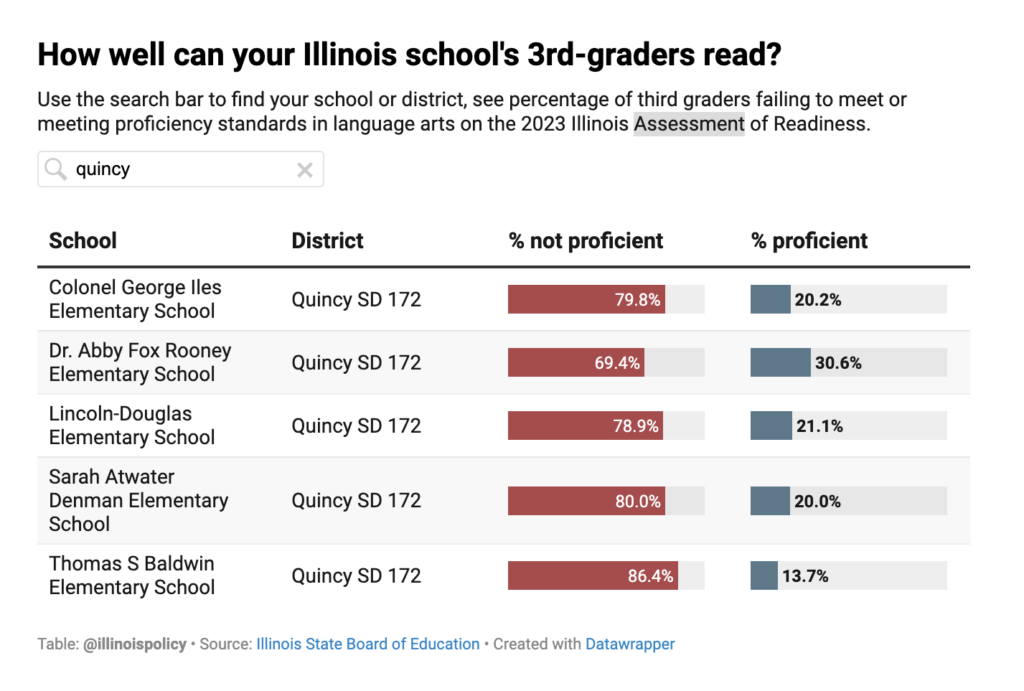Illinois third grade reading scores by school

CLICK HERE to look up how third graders in your local schools are reading.

Third grade is a critical reading milestone because students need to have learned to read by then or they will not be able to absorb the rest of their education.
“Students who do not ‘learn to read’ during the first three years of school experience enormous difficulty when they are subsequently asked to ‘read to learn,’” according to the National Center to Improve the Tools of Educators.
Thousands of Illinois third graders are set to experience enormous difficulty in the years to come as nearly three-quarters did not meet Common Core Standards in reading on the Illinois Assessment of Readiness in 2023.
Students will not be the only ones to suffer the consequences of Illinois’ low reading proficiency rate. Society will pay the cost for the reading struggles of Illinois’ early elementary students.
A student’s reading skill at the end of third grade is a reasonable predictor for their likelihood to graduate high school. If Illinois does not prepare its students to read proficiently by the end of third grade, it must expect more students to drop out of high school. High school dropouts have a higher unemployment rate and the cost to the economy is often lower tax contributions and higher reliance on welfare.
Parents and lawmakers need to understand the scope of the literacy epidemic in Illinois. They then must work together to ensure every Illinois student has the opportunity to receive a quality education and the preparation needed to succeed after graduation.
Third grade is critical reading juncture for students
Research shows students who fall behind in reading skills, especially in lower elementary grade levels, “fall farther and farther behind in school, become frustrated, and drop out at much higher rates than their classmates.”
This is because students need to have mastered the skill of reading by third grade so they can use reading to learn from fourth grade onwards. According to the Children’s Reading Foundation, if a student struggles to read at grade level by this critical point, up to half of the printed fourth-grade curriculum is incomprehensible.
Students who can’t read by third grade are more likely to have trouble mastering other subjects such as history or math. They need to read to understand the concepts being taught.
Illinois uses Common Core State Standards for English language arts on the Illinois Assessment of Readiness. Reading standards are separated into three focus areas: literature, informational text and foundational skills.
According to Common Core, “The K–5 standards… define what students should understand and be able to do by the end of each grade.”
By the end of third grade, students who meet proficiency in reading on the IAR understand and are able to do the following skills, among others:
- “Ask and answer questions to demonstrate understanding of a text, referring explicitly to the text as the basis for the answers.”
- “Determine the main idea of a text; recount the key details and explain how they support the main idea.”
- “Describe the relationship between a series of historical events, scientific ideas or concepts, or steps in technical procedures in a text, using language that pertains to time, sequence, and cause/effect.”
- “Know and apply grade-level phonics and word analysis skills in decoding words.”
- “Read with sufficient accuracy and fluency to support comprehension.”
These skills become the building blocks for Illinois students to succeed in subsequent grade levels. Unfortunately, many Illinois third grade students have not mastered these skills.
Few third graders can read at grade level, hitting low-income and minority students harder
In 2023, not even 29% of Illinois third-grade students met or exceeded reading proficiency standards on the IAR. That means 7 in 10 third graders could not read at grade level.
Third-grade students recorded the lowest percentage of students able to read at grade level compared to every other grade level tested on the IAR in 2023.
Not a single third-grade student could read at grade level in 81 of Illinois’ public schools. Chicago Public Schools accounted for 51 of those. Two of the other schools, Hazel Dell Elementary School and Laketown Elementary School, are located in Springfield, the state’s capital.
The statistics are even worse among Illinois’ minority and low-income students. Only 13% of Black third graders and 17% of Hispanic third graders read at grade level on the IAR in 2023. Only 16% of low-income third graders reached proficiency.
While 32 Illinois public schools had no white third-grade students proficient in reading, there were 110 schools with no Black third graders able to read at grade level and 69 schools where no Hispanic third graders could read at grade level.
There were 156 schools where not a single low-income, third-grade student could read at grade level.
Low reading proficiency hits all Illinois grades
While third grade is an important indicator of a student’s future academic success and a particular point of interest, students in every grade in Illinois are struggling to meet grade level standards in reading.
Students in grades 3 through 8 take the IAR each spring, which includes a reading assessment. Eleventh grade students take the SAT to assess proficiency in reading.
In 2023, eighth grade students achieved the highest proficiency rate in reading compared to the other grades tested, yet even among that group not even 41% met grade level standards in reading.
In each grade, Black students achieved reading proficiency at the lowest rate, followed by Hispanic students. Low-income students also achieved proficiency in reading at much lower rates.
16 states outperform Illinois on Nation’s Report Card
Every two years, the National Center for Education Statistics administers the National Assessment of Educational Progress, which is also known as “The Nation’s Report Card.” According to the center, the purpose of the assessment’s scores is “to measure the educational achievement and progress of the nation’s students at established grades and ages.” Additionally, the scores allow comparisons of students between states.
The assessment evaluates elementary school students in fourth grade, middle school students in eighth grade and high school students in 12th grade.
Like the results of Illinois’ IAR testing, the assessment reports just 33% of Illinois fourth-grade public school students performed at or above proficiency standards in reading in 2022.
Sixteen states had a higher percentage of fourth-grade public school students at or above the assessment’s proficiency standards for reading compared to Illinois.
In the Midwest, three additional states had 33% proficiency among fourth graders on the reading assessment: Iowa, Indiana and Wisconsin.
Ohio and Nebraska are the only Midwestern states with a higher percentage of fourth graders performing at or above reading proficiency than Illinois, with 35% in Ohio and 34% in Nebraska. The other six Midwestern states had a lower percentage, including four states – North Dakota, Kansas, Missouri and Michigan – which recorded a lower percentage than the national percentage of 32%.
Illinois outperformed the national percentage by one percentage point.
Reading struggles in lower elementary grades lead to high-school dropouts
A report by the Annie E. Casey Foundation warns about these negative effects of a student’s inability to read effectively by the end of third grade. The research shows a student’s likelihood to graduate high school can be predicted with reasonable accuracy by their reading skill at the end of third grade. By the beginning of fourth grade, students transition from learning to read to reading to learn.
The authors warn that “if we don’t get dramatically more children on track as proficient readers, the United States will lose a growing and essential proportion of its human capital to poverty, and the price will be paid not only by individual children and families, but by this entire country.”
The price paid by students for poor third-grade literacy is lower future earning potential. The median annual earnings of adults ages 25 through 34 who had not completed high school were $6,000 a year lower than the earnings of those with a diploma, according to data from the Census Bureau’s 2017 Current Population Survey.
The unemployment rate for high school dropouts was 13% compared to the 7% unemployment rate of those whose highest level of educational was a high school credential.
Additionally, the average high school dropout cost the economy approximately $272,000 compared to individuals who complete high school because of “lower tax contributions, higher reliance on Medicaid and Medicare, higher rates of criminal activity, and higher reliance on welfare,” according to the National Center for Education Statistics.
Data from the Census Bureau’s 2022 American Community Survey found 9.6% of Illinoisans aged 25 and over never earned their high school diploma. That includes 5% who failed to reach higher than ninth grade.
Only 17 states have a higher portion of individuals over age 25 who have not earned their high school diploma. Illinois has the second-highest rate in the Midwest, with only Indiana recording a higher percentage of those aged 25 and over without a high school diploma at 9.8%.
Illinois students deserve a quality education
Students in Illinois schools should receive quality teaching which prepares them to flourish in life after graduation. Too many students are struggling to meet grade-level standards in Illinois public schools. This threatens students’ futures plus threatens to be a burden on the rest of society.
Ensuring students have the tools and instruction necessary to read at grade level in their early years of schooling can help keep students engaged in their later years, through to high school graduation and brighter futures.
Miss Clipping Out Stories to Save for Later?
Click the Purchase Story button below to order a print of this story. We will print it for you on matte photo paper to keep forever.

